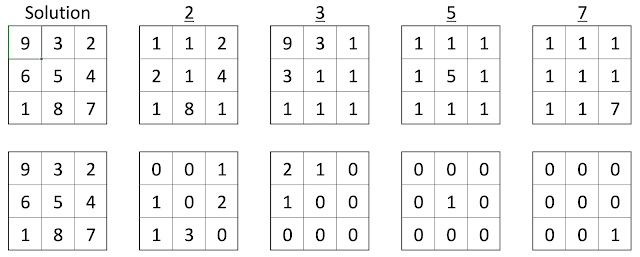Let's say an
Independent Aurelian is investigating butterflies on two types of traits, A and B. It is known that the probability of a butterfly exhibiting trait A is $p$ and that of trait B is $q$ (independent of each other). Note that this means the probability of a butterfly exhibiting both these traits is $pq$.
If she wants to study both these traits, how many butterflies, on average, would she need to catch? She can do this either by catching two butterflies each with exactly on of these traits or by catching a butterfly with both these traits.
The problem is simple and that subject of this post is look at five different methods of this problem. A key fact that will be of great use in all these methods is that for an event with success probability $r$, we would need, on average, $1/r$ trials to get the first success.
Simple equation
Let $N$ be the expected value we are looking for. We can condition this based on the nature of the first butterfly that is caught.
$\displaystyle N=(1-p)(1-q)\cdot(1+N)+(1-p)q\cdot \left(1+\frac{1}{p}\right)+p(1-q)\cdot\left(1+\frac{1}{q}\right)+pq\cdot 1$
Transfer Matrix
It is easy to setup the transfer matrix for this problem with the states being $\{\text{None, Only trait }A\text{, Only trait }B\text{, Both}\}$. Then the transfer matrix $\mathbf{T}$ is,
$\displaystyle \mathbf{T}=\begin{pmatrix}1-(1-p)(1-q)&p(1-q)&(1-p)q&pq \\ 0&1-q&0&q \\ 0&0&1-p&p \\ 0&0&0&1\end{pmatrix}$
It is then well known that the expected value is given by $\mathbf{1}(\mathbf{I}-\mathbf{T})^{-1}$ where $\mathbf{I}$ is the identity matrix and $\mathbf{1}$ is a row matrix of 1's.
Infinite Series
Let's say we've caught $n$ butterflies. The probability that none of them have trait A is $(1-p)^n$ which means that atleast one of them have trait A is $1-(1-p)^n$ and the same applies for trait B as well (with $p$ replaced with $q$).
$\mathbb{P}(\text{atleast of one each of both traits in }n\text{ trials})=(1-(1-p)^n)(1-(1-q)^n)$
With this, we see that $\mathbb{P}(N>n)=1-(1-(1-p)^n)(1-(1-q)^n)$
Then, $\displaystyle \mathbb{E}(N)=\sum_{n=0}^\infty \mathbb{P}(N>n)=\sum_{n=0}^\infty \Bigl (1-(1-(1-p)^n)(1-(1-q)^n) \Bigl )$
Story proof
We can answer this more directly. The expected number of butterflies needed can be broken into parts. First, expected number to get atleast one of the traits and second, the remaining value.
The probability of a butterfly exhibiting one of the traits is $1-(1-p)(1-q)=p(1-q)+(1-p)q+pq$. Therefore, we would need $1/(1-(1-p)(1-q))$ trials to get atleast of the traits. Now,
$\displaystyle \mathbb{P}(\text{Only trait A}|\text{atleast one of the traits})=\frac{p(1-q)}{p(1-q)+(1-p)q+pq}=\frac{p(1-q)}{1-(1-p)(1-q)}$
After having got trait A, we would be looking for trait B which we would get, on average, in $1/q$ trails. This approach applies for the other two cases as well. Therefore,
$\displaystyle\mathbb{E}(N)=\frac{1}{1-(1-p)(1-q)}+\frac{p(1-q)}{1-(1-p)(1-q)}\cdot\frac{1}{q}+\frac{(1-p)q}{1-(1-p)(1-q)}\cdot\frac{1}{p}+\frac{pq}{1-(1-p)(1-q)}\cdot 0$
(Shorter story proof using) Min-Max identity
It is easy to see that $x_1+x_2=\max (x_1,x_2)+\min (x_1,x_2)$ for any two real $x_1,x_2$.
Using this and the linearity of expectations, we have,
$\mathbb{E}(N)=\mathbb{E}(\text{trials to get trait A})+\mathbb{E}(\text{trials to get trait B})-\mathbb{E}(\text{trials to get atleast one of the traits})$
All of these are Geometric random variables with probabilities $p$, $q$ and $p+q-pq$. Therefore,
$\displaystyle \mathbb{E}(N)=\frac{1}{p}+\frac{1}{q}-\frac{1}{p+q-pq}$
Where's the fun in solving a problem if getting an answer is the only objective?
Yours Aye
Me








.png)
.png)
.png)
.png)


.png)


.png)